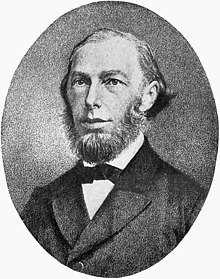Max Schultze
Max Johann Sigismund Schultze (25 March 1825 – 16 January 1874) was a German microscopic anatomist noted for his work on cell theory.
Max Johann Sigismund Schultze | |
|---|---|
 Max Johann Sigismund Schultze c.1860 | |
| Born | 25 March 1825 Frerg |
| Died | 16 January 1874 (aged 48) |
| Nationality | German |
| Alma mater | Halle |
| Known for | Discovery of Protoplasm Theory |
| Scientific career | |
| Fields | anatomist |
Biography
Schultze was born in Freiburg im Breisgau (Baden). He studied medicine at Greifswald and Berlin, and was appointed an associate professor of anatomy at Halle in 1854. Five years later he became a full professor of anatomy and histology and director of the Anatomical Institute at the University of Bonn.[1] He died in Bonn on 16 January 1874; his successor at the anatomical institute being Adolph von La Valette-St. George.[2] He was the older brother of obstetrician Bernhard Sigmund Schultze (1827–1919).
He founded, in 1865, and edited the important "Archiv für mikroskopische Anatomie", to which he contributed many papers, and he advanced the subject generally, by refining on its technical methods. His works included:
- Beiträge zur Naturgeschichte der Turbellarien (1851).
- Uber den Organismus der Polythalamien (1854).
- Beiträge zur Kenntnis der Landplanarien (1857).
- Zur Kenntnis der elektrischen Organe der Fische (1858).
- Ein heizbarer Objecttisch und seine Verwendung bei Untersuchungen des Blutes,[3] (In 1865 Schultze provided the first accurate description of the platelet).[4]
- Zur Anatomie und Physiologie der Retina (1866).
His name is especially known for his work on the cell theory. Uniting Félix Dujardin's conception of animal sarcode with Hugo von Mohl's of vegetable protoplasma, he pointed out their identity, and included them under the common name of protoplasm, defining the cell as a nucleated mass of protoplasm with or without a cell wall (Das Protoplasma der Rhizopoden und der Pflanzenzellen; ein Beiträg zur Theorie der Zelle, 1863).
Max Schultze studied medicine with the naturalist Fritz Müller, a German biologist and doctor who became a naturalized Brazilian. It was mainly because of his friendship and correspondence with Schultze that Müller to some extent was able to follow the debate in Europe about Darwin's theory of evolution. Max periodically sent him scientific literature, among which was Darwin's On the Origin of Species, and a small microscope manufactured in Berlin, by Friedrich Wilhelm Schiek (1857). Thanks to this microscope, Müller hypothesized from his own studies that "all higher Crustacea probably will be traceable to a Zoea ancestor". Based on these studies Müller also wrote his book Für Darwin, in defense of Darwin's theories, corroborating the theory of natural selection.[5]
See also
References
- "Schultze, Max(imilian) Johann Sigismund", in Neue Deutsche Biographie (NDB). Band 23, Duncker & Humblot, Berlin 2007, ISBN 978-3-428-11204-3, pp. 703 ff.
- University of Illinois (Urbana-Champaign campus). College of Medicine. Dept. of Anatomy (1917). Studies from the Dept. of Anatomy, University of Illinois College of Medicine, Chicago. 3. pp. 340–.
- Schultze, Max (1865). "Ein heizbarer Objecttisch und seine Verwendung bei Untersuchungen des Blutes" (PDF). Archiv für Mikroskopische Anatomie. 1: 1–42. doi:10.1007/BF02961404.
- Brewer, D. B. (2006). "Max Schultze (1865), G. Bizzozero (1882) and the discovery of the platelet". British Journal of Haematology. 133 (3): 251–8. doi:10.1111/j.1365-2141.2006.06036.x. PMID 16643426.
- Di Gregorio, Mario A. (2005). From Here to Eternity: Ernst Haeckel and Scientific Faith. Vandenhoeck & Ruprecht. p. 170. ISBN 978-3-525-56972-6.
- IPNI. M.Schultze.
Sources

- . New International Encyclopedia. 1905.